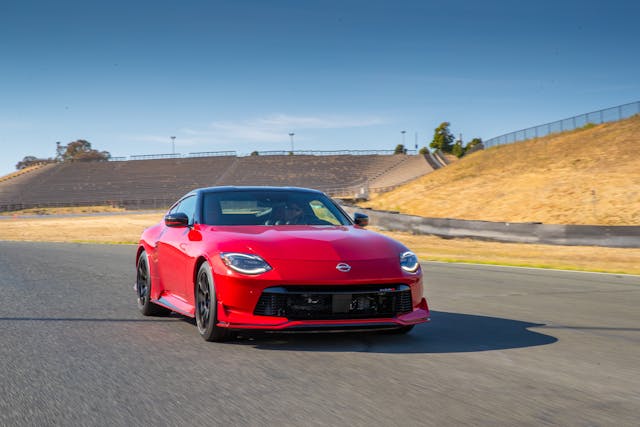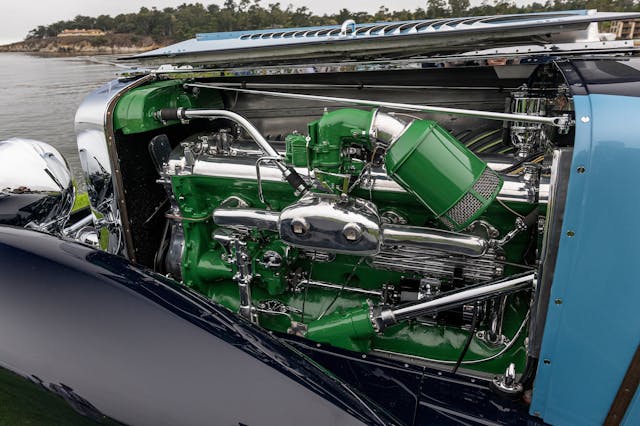Our Two Cents: The Goldilocks Horsepower Number
As you may recall, Goldilocks is the story of a woman eating from three bowls of porridge. Said bowls were at various temperatures, but only one was right for her. The same can be true for horsepower figures, as the Lucid Air Sapphire has a scalding 1234 hp. The Mitsubishi Mirage only has 78 hp, which is certainly too cold in our modern automotive climate. So what’s the Goldilocks horsepower number?


That’s the question we posed to the staff here at Hagerty Media, and our answers are just as diverse as our tastes in cars. So have a look at our thoughts, because what’s “just right” for one staffer might not work for others.
400 horses

400: This is pretty easy to get out of most modern engine designs while still having a durable, dependable, and serviceable powerplant. It’s also usually enough to spin the tires when you want to while still returning decent fuel economy. — Kyle Smith
650 horses?

550–650 hp in most applications (modern performance, big SUV, etc.) is about right for day-to-day. Goldilocks, however, is 700–900 hp via a nicely built RY45. — Matt Tuccillo
A “Weighty” Question

You can’t say for sure without knowing the weight. The sweet spot for me is 300 hp, but only saddled to 2600 pounds. Also, peak power doesn’t mean much to me either because if all the power is over 5000 rpm and the engine is asleep at 4000 (where I mostly drive) then I don’t care what those figures are. Okay, more than you wanted to know. — Larry Webster
This is Irrelevant!

Horsepower is meaningless in the age of electrification. The only numbers that matter anymore are range, consumption, and torque. In older cars, horsepower figures are either deliberately inflated (pre-SAE) and/or irrelevant. Does anyone care what the horsepower figure is for a Porsche 912? A Ferrari 250 GTO? A 260 Mustang vs a 289? It’s rare that anyone ever asks me the horsepower of my old cars and for most of them (’36 Riley, ’49 Buick, ’67 Porsche 912, ’73 Land Rover) I couldn’t even tell you, but it doesn’t diminish my interest in them. Goldilocks horsepower? As the man said, I know it when I see it. — Aaron Robinson
Less than 400


I’ll go out on a limb and say that anything much more than 400 horsepower is really just a unit of … well, member measurement for the average skilled driver in an AWD or RWD platform. Make it FWD and I’d go as low as 250–300 horsepower. Straight-line speed is fun, but moderate power where you can plant your foot and not get in too much trouble (either from lack of skill or that by way of that cop you didn’t notice) is my preferred state. — Greg Ingold
36 Horsepower

The answer is 36 hp—in my 370 lb go-kart, anyway. Any less and it wouldn’t scare me, and any more would probably make it illegal in my class. — Eddy Eckart
2400 horsepower!

Sorry y’all, but I gotta get all Texas up in here. Texas mile and TX2K to be precise, and we will take the biggest figure the aftermarket provides. I’ve driven a couple of 1000+hp, pump gas Lambos and they provide tame performance in traffic, while also offering mind-altering thrust in places like Mexico.
But it’s been a minute, and the number of turbocharged Lambos with 1500+ horsepower to the wheels suggests that might be about right for my needs. But 2400 horsies at all four wheels sounds delightful, as my foot knows how to treat a throttle pedal like a rheostat and not an on/off switch. Texas Tea also comes in race formulations, dont’cha know? — Sajeev Mehta
***
Check out the Hagerty Media homepage so you don’t miss a single story, or better yet, bookmark it. To get our best stories delivered right to your inbox, subscribe to our newsletters.



Depends upon the weight, but maybe about 400 horses.
I like the 400 HP I have in my 1965 Mustang Fastback 2+2. It’s a Roush 331 SRX. Sounds good with Magna Flow mufflers and looks good under the hood.
A thundering 100 horsepower will do it. You’re in a tired Cessna 150, short grass strip, trees at the end of the runway. Lemmetellya, in that situation, 80 miles and hour is FAST and will pucker you right up. (You did check the manual for performance specs, right?)
my 2900 pound car is propelled by a Buick 3.8 liter turbo V6, my guess is it’s putting out close to 400 HP, originally it was rated at 235 HP but with many improvements I’m thinking its about double, even with a two series geared rear end its way to fast for the way I drive but loads of fun.
300hp, 340lb-ft torque, 6-speed transmisson suits me.
I’ll have enough horsepower when I can spin the tires at the far end of a long straight.
Attributed to Mark Donahue. I like it.
It depends on the use of the vehicle and the size/weight. My work truck, an old (2003) Tundra with just over 300,000 miles is rated at 245 hp @ 4800 rpm. I’ve never hit 4800 rpm, usually run in the 1500-2500 range. TORQUE is more of a performance indicator to me. That same engine is rated at 315 ft/lbs at 3400 rpm, again, something I don’t see in normal driving. It hit that on occasion when I used it to tow a 6500 lb (empty) camper — so I was running around the max recommended tow capacity of 7200 lbs. It would only down-shift if I were pressing it up a big hill, like the SC/NC mountains. It usually ran along even up steep grades (like the Saluda grade on I-40) in 3rd gear at around 2800-3000 rpm (and ~45 mph) — unless I pressed it to go faster, at which point it would down-shift into 2nd and run rpm up, but not go much faster.
I tell people who want to build a “400 hp engine” for their street car to forget it. 400 hp @ 6000 rpm is attainable. You never hit that in a real world situation though. In reality that engine shouldn’t be hitting more than around 3000 rpm, and running in a 1500-2500 range most of the time. Build for a torque peak in the 2000-3000 range for a regularly street driven vehicle and forget about the hp numbers — they are just bragging rights. A 200 hp engine (like the ~225 hp hopped up Jeep 4.0L in my 63 Rambler Classic) will easily keep up with modern traffic. That’s in a 3200 pound very non-aerodynamic car. It’s a great cruiser and performs well around town, better than some mid range modern sedans, but without the gas mileage.
If your goal is best economy is what you want, a drag racer a big one, and a road racer somewhere in between. It really does depend on what you want to do! For all around driving 200-300 hp in a car under/around 3000 lbs. is probably what you’re looking for. But that depends on where torque comes in…
I think it intersting that only one of this group who were asked,talked about weight…THAT is the magic # when it comes to the amount of horsepower that is best…you can have a million HP but if the vehicle is too heavy,it isn’t going to matter…power to weight,THAT is the formula that determins how fast mass can be moved……
Quite the pissing contest this article started. Most people are not being honest when it comes to horsepower numbers. It’s like many fishing stories, the fish was actually smaller than stated.
my vehicles. are perfect with 400 hp. the firebird 400 has 400 ft lbs of torque at 1800 rpm, a 2600 rpm torque converter. it will only go 3 feet till the 10″ tires hook up (274 rear gear) gets 16 mpg. a nice freeway cruiser. my 04 Silverado SS. HAS TRACTION control its all wheel drive and is quick as a rocket. I can pull out in front of anyone and leave them in the dust. hard as they try they can’t catch up to me. when it was new before taller pistons cam and hp tuners. I raced a Ferrari from a stoplight. stayed a front fender ahead as he rowed through the gears. at 70 mph I made a right turn into where I was going, then he got ahead. enjoyed all of this article, stoped going a hundred mph every day about 5 years ago, figured odds were against me.
It’s more than horsepower that makes a good ride. I had a 71 GMC K10 pickup with a 307, total dog. A 350 only helped a little. I put that 307 2b in a 55 Chevy Bel Air hardtop with a T10, it was just a great combination. Not a burnout machine, but had plenty of power and averaged 20+ mpg without overdrive. Just fun to drive.
Many interesting comments some good some not so good. I personally am not a fan of the horsepower race of the last 15 years or so. The horsepower in today’s street cars is insane!!! The average person cannot handle it and will get themselves killed!
We do plenty of things that aren’t smart but make life worth living. Among them, throwing a car around. If I don’t have the horsepower for a dry powerslide a sandy or wet parking lot will do, and nobody needs to be watching. It’s just FUN! You can tell when hyperv6 is triggered, he gets serious enough to proofread his comments.
Horsepower numbers are mostly useless without knowing the vehicle weight. In my opinion, somewhere around the 10 lbs per horse figure feels right. My Seven clone is 1,350 lbs and has roughly 150 naturally aspirated horses. It is an absolute blast to drive. Could it use a few more? Sure, but are they necessary for a good time? Nope.
anything Above 150 HP is a waste unless your using it at the Track-